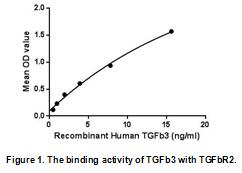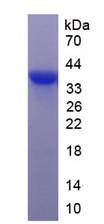Active Transforming Growth Factor Beta 3 (TGFb3) 

TGF-B3; LAP; Latency-associated peptide
- UOM
- FOB US$ 354.00 US$ 885.00 US$ 1,770.00 US$ 5,310.00 US$ 13,275.00
- Quantity
Overview
Properties
- Product No.APB949Hu02
- Organism SpeciesHomo sapiens (Human) Same name, Different species.
- ApplicationsCell culture; Activity Assays.
Research use only - DownloadInstruction Manual
- CategoryCytokineTumor immunityInfection immunity
- Buffer FormulationPBS, pH7.4, containing 0.01% SKL, 1mM DTT, 5% Trehalose and Proclin300.
- Traits Freeze-dried powder, Purity > 95%
- Isoelectric Point8.9
Sign into your account
Share a new citation as an author
Upload your experimental result
Review

Contact us
Please fill in the blank.
Activity test

Transforming growth factor beta-3 (TGFb3) is a type of protein, known as a cytokine, which is involved in cell differentiation, embryogenesis and development. It belongs to a large family of cytokines called the Transforming growth factor beta superfamily. TGFb3 is believed to regulate molecules involved in cellular adhesion and extracellular matrix (ECM) formation during the process of palate development. It also plays an essential role in controlling the development of lungs in mammals, by also regulating cell adhesion and ECM formation in this tissue, and controls wound healing by regulating the movements of epidermal and dermal cells in injured skin. Besides, Transforming Growth Factor Beta Receptor II (TGFbR2) has been identified as an interactor of TGFb3, thus a binding ELISA assay was conducted to detect the interaction of recombinant human TGFb3 and recombinant human TGFbR2. Briefly, TGFb3 were diluted serially in PBS, with 0.01% BSA (pH 7.4). Duplicate samples of 100uL were then transferred to TGFbR2-coated microtiter wells and incubated for 2h at 37℃. Wells were washed with PBST and incubated for 1h with anti-TGFb3 pAb, then aspirated and washed 3 times. After incubation with HRP labelled secondary antibody, wells were aspirated and washed 3 times. With the addition of substrate solution, wells were incubated 15-25 minutes at 37℃. Finally, add 50µL stop solution to the wells and read at 450nm immediately. The binding activity of TGFb3 and TGFbR2 was shown in Figure 1, and this effect was in a dose dependent manner.
Usage
Reconstitute in 10mM PBS (pH7.4) to a concentration of 0.1-1.0 mg/mL. Do not vortex.
Storage
Avoid repeated freeze/thaw cycles. Store at 2-8°C for one month. Aliquot and store at -80°C for 12 months.
Stability
The thermal stability is described by the loss rate. The loss rate was determined by accelerated thermal degradation test, that is, incubate the protein at 37°C for 48h, and no obvious degradation and precipitation were observed. The loss rate is less than 5% within the expiration date under appropriate storage condition.
Increment services
-
 BCA Protein Quantification Kit
BCA Protein Quantification Kit
-
 Molecular Mass Marker for Protein
Molecular Mass Marker for Protein
-
 Monoclonal Antibody Customized Service
Monoclonal Antibody Customized Service
-
 Polyclonal Antibody Customized Service
Polyclonal Antibody Customized Service
-
 Protein Activity Test Experiment Service
Protein Activity Test Experiment Service
-
 Electrophoretic Mobility Shift Assay (EMSA) Experiment Service
Electrophoretic Mobility Shift Assay (EMSA) Experiment Service
-
 Buffer
Buffer
-
 Lentivirus Packaging Experiment Service
Lentivirus Packaging Experiment Service
-
 Adenovirus Packaging Experiment Service
Adenovirus Packaging Experiment Service
-
 Real Time PCR Experimental Service
Real Time PCR Experimental Service
-
 Spike RBD Protein (S-RBD)
Spike RBD Protein (S-RBD)
-
 Protein G
Protein G
-
 Protein A
Protein A
Citations
- A Combinatorial Relative Mass Value Evaluation of Endogenous Bioactive Proteins in Three-Dimensional Cultured Nucleus Pulposus Cells of Herniated Intervertebral Discs: Identification of Potential Target Proteins for Gene Therapeutic ApproachesPlosone: Source
- The immunomodulating effect of seminal plasma on T cellsPubMed: 25799173
- Influence of vitamin D and transforming growth factor β3 serum concentrations, obesity, and family history on the risk for uterine fibroidspubmed:27743697
- New scaffolds encapsulating TGF-β3/BMP-7 combinations driving strong chondrogenic differentiationpubmed:28087378
- Transforme edici büyüme faktörü-beta-1 nötralizan antikoru ve transforme edici büyüme faktörü-beta-3'ün trakeal darlık gelişimi üzerine etkileri10.5606/tgkdc.dergisi.2017.14302
- Ulipristal acetate decreases transforming growth factor β3 serum and tumor tissue concentrations in patients with uterine fibroidsPubmed:29525690
- TGF-β concentrations and activity are down-regulated in the aqueous humor of patients with neovascular age-related macular degenerationPubmed:29795291
- The involvement of multifunctional TGF-β and related cytokines in pathogenesis of endometriosisPubmed: 30367890
- Transforming Growth Factor-β3 Regulates Adipocyte Number in Subcutaneous White Adipose TissuePubmed: 30332637
- Temporal TGF-β Supergene Family Signalling Cues Modulating Tissue Morphogenesis: Chondrogenesis within a Muscle Tissue Model?Pubmed: 32660137
- Limited added value of negative pressure wound therapy compared to calcium alginate dressings for second intention healing in a non©\contaminated and?¡34115409
- Nanoparticles and Nanostructured Films with TGF-β3: Preparation, Characterization, and Efficacy34378118







